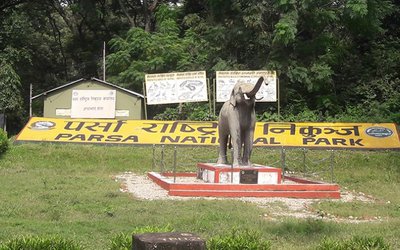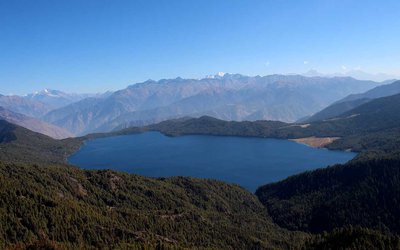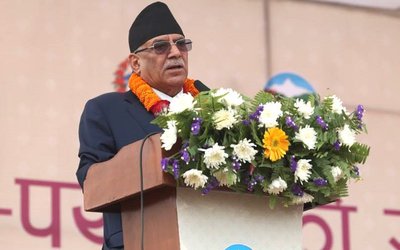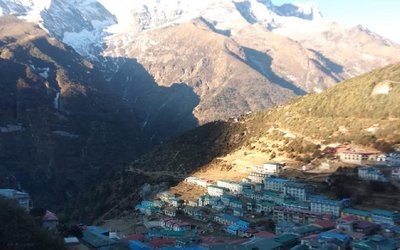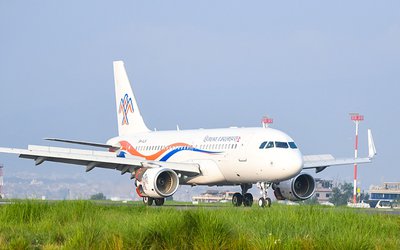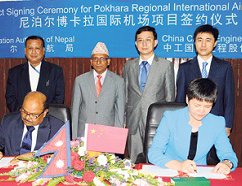
People of Pokhara have staged rallies, held fasts and street protests for the last two years with a demand for construction of Pokhara Regional International Airport (PRIA). However, after two years, the Civil Aviation Authority of Nepal and China CAMC Engineering Company Ltd(CAMCE) signed the agreement for the construction of the airport.
Although Asian Development Bank also agreed to support the construction of an international Airport in Bhairawa, this is yet to take happen due to certain technicalities. At a time when Nepal is planning to bring over 2 million tourists and provide services to over 2 million foreign workers, Nepal requires a few more international airport, along with the Tribhuwan International Airport (TIA).
As the TIA is still to run in its full capacity, the runway remaining idle for over 5 hours during the night, economists pose the question for the economic sustainability of several international airports in the country. Thus, critics have questioned the regional international airport in Pokhara as well.
The CAAN Employee Union issued a statement saying that it was against the signing of a deal for the Pokhara airport as the project was not feasible -- both technically and financially. The union’s argument has been that CAAN, whose annual income is around Rs 3.5 billion, is not in a condition to bear additional loans of Rs 25 billion as it already has Rs 20 billion in loans.
However, Luo Yan, the chairman and president of CAMCE, and Ratish Chandra Lal Suman, the director general of CAAN, signed the agreement amid a function held at CAAN, paving the way for construction. On April 7, the CAAN board gave the green signal for the construction of the controversial regional international airport in Pokhara. That meeting of the CAAN board, chaired by the tourism and civil aviation minister Bhim Acharya, approved the project under a revised cost of $216 million as recommended by an independent three-member panel formed by the government.
“The project is very important to us and we will contribute our expertise and do our best to finish the it within the scheduled time,” Lou said, adding that CAMCE will meet all the requirements put forward by the government for the construction of the airport.
CAAN had invited tenders for the airport in the BoQ (Bills of Quantities) model with the estimated cost at US$ 145 million. But the contract has been signed in the Engineering Procurement and Construction (EPC) model with costs estimated at up to US$ 216 million.
“Appointing a contractor for PRIA is a very important part of the project and we are happy to work with CAMCE. The construction of PRIA, which has been pending for the last 40 years, will promote tourism and contribute to raising the gross domestic product (GDP),” said Suman.
The airport project has been on hold since July 2012 after the lowest bidder -- China CAMC -- bid $305 million, which was 85 percent higher than the cost estimated by Nepal. The government had anticipated the project would cost around $166 million.
The construction area of Pokhara Airport is about 200 hectares and the runway will be around 2,500 meters long and 45 meters wide, which according to CAMCE will be appropriate for landings and taking-offs for aircraft at the airport. CAMCE says that the airport will be one of the most modern airports in Nepal. The PRIA project is one of the largest economic and technical cooperation projects between Nepal and China and it is expected to complete within four years.
With the annual interest rate of 8 percent, the government will take concessional loans from Exim Bank of China.
The government acquired 3,106 ropanis of land at Chinedanda for PRIA 38 years ago and this year it plans to add 500 ropanis to the project as the new study suggests that it requires additional land. To acquire the additional land, the government has put aside Rs 1 billion for this Fiscal Year. CAMCE will construct the runway, taxi-way, apron, international and domestic terminal buildings, air-traffic control tower, cargo terminal building and airport hangar.
The government and Japan International Cooperation Agency (JICA) carried out a detailed study for the feasibility of the airport project in 1989. At that time, the study had proposed a 2,500 meters long and 50 meters wide runway, a terminal and a cargo building
People of Pokhara have staged rallies, held fasts and street protests for the last two years with a demand for construction of Pokhara Regional International Airport (PRIA). However, after two years, the Civil Aviation Authority of Nepal and China CAMC Engineering Company Ltd(CAMCE) signed the agreement for the construction of the airport.
Although Asian Development Bank also agreed to support the construction of an international Airport in Bhairawa, this is yet to take happen due to certain technicalities. At a time when Nepal is planning to bring over 2 million tourists and provide services to over 2 million foreign workers, Nepal requires a few more international airport, along with the Tribhuwan International Airport (TIA).
As the TIA is still to run in its full capacity, the runway remaining idle for over 5 hours during the night, economists pose the question for the economic sustainability of several international airports in the country. Thus, critics have questioned the regional international airport in Pokhara as well.
The CAAN Employee Union issued a statement saying that it was against the signing of a deal for the Pokhara airport as the project was not feasible -- both technically and financially. The union’s argument has been that CAAN, whose annual income is around Rs 3.5 billion, is not in a condition to bear additional loans of Rs 25 billion as it already has Rs 20 billion in loans.
However, Luo Yan, the chairman and president of CAMCE, and Ratish Chandra Lal Suman, the director general of CAAN, signed the agreement amid a function held at CAAN, paving the way for construction. On April 7, the CAAN board gave the green signal for the construction of the controversial regional international airport in Pokhara. That meeting of the CAAN board, chaired by the tourism and civil aviation minister Bhim Acharya, approved the project under a revised cost of $216 million as recommended by an independent three-member panel formed by the government.
“The project is very important to us and we will contribute our expertise and do our best to finish the it within the scheduled time,” Lou said, adding that CAMCE will meet all the requirements put forward by the government for the construction of the airport.
CAAN had invited tenders for the airport in the BoQ (Bills of Quantities) model with the estimated cost at US$ 145 million. But the contract has been signed in the Engineering Procurement and Construction (EPC) model with costs estimated at up to US$ 216 million.
“Appointing a contractor for PRIA is a very important part of the project and we are happy to work with CAMCE. The construction of PRIA, which has been pending for the last 40 years, will promote tourism and contribute to raising the gross domestic product (GDP),” said Suman.
The airport project has been on hold since July 2012 after the lowest bidder -- China CAMC -- bid $305 million, which was 85 percent higher than the cost estimated by Nepal. The government had anticipated the project would cost around $166 million.
The construction area of Pokhara Airport is about 200 hectares and the runway will be around 2,500 meters long and 45 meters wide, which according to CAMCE will be appropriate for landings and taking-offs for aircraft at the airport. CAMCE says that the airport will be one of the most modern airports in Nepal. The PRIA project is one of the largest economic and technical cooperation projects between Nepal and China and it is expected to complete within four years.
With the annual interest rate of 8 percent, the government will take concessional loans from Exim Bank of China.The government acquired 3,106 ropanis of land at Chinedanda for PRIA 38 years ago and this year it plans to add 500 ropanis to the project as the new study suggests that it requires additional land. To acquire the additional land, the government has put aside Rs 1 billion for this Fiscal Year. CAMCE will construct the runway, taxi-way, apron, international and domestic terminal buildings, air-traffic control tower, cargo terminal building and airport hangar.
The government and Japan International Cooperation Agency (JICA) carried out a detailed study for the feasibility of the airport project in 1989. At that time, the study had proposed a 2,500 meters long and 50 meters wide runway, a terminal and a cargo building.
- TANAHU HYDROPOWER PROEJCT: A Significant Achievement
- Apr 15, 2024
- AMBASSADOR HANAN GODAR: Sharing Pain With A Nepali Family
- Mar 30, 2024
- VISIT OF KfW AND EIB TO NEPAL : Mission Matters
- Mar 25, 2024
- NEPAL BRITAIN SOCIETY: Pratima Pande's Leadership
- Mar 24, 2024
- NEPAL ARMY DAY: Time To Recall Glory
- Mar 15, 2024


